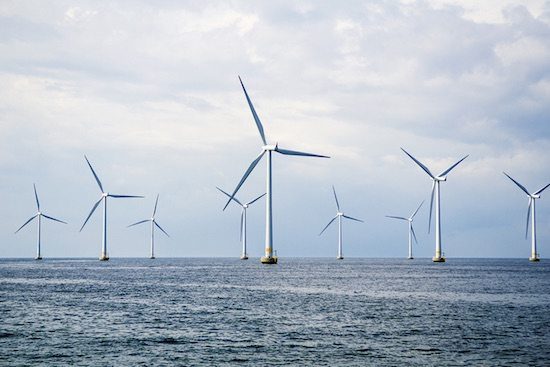Plans for what could be Australia’s first offshore wind farm have been unveiled, revealing an ambitious proposal for an $8 billion, 2GW, 250 turbine project off the coast of Gippsland in Victoria’s east.
The project, which was being presented to a state government New Energy Technology Roundtable on Friday, is the brainchild of five-year old Melbourne-based renewables outfit, Offshore Energy – headed up by veteran wind energy executive Andy Evans and the former chief of geothermal hopeful Petratherm, Terry Kallis.
Dubbed the Star of the South Energy Project, the wind farm is currently at a the very early, pre-feasibility stage – and the feasibility, alone, will be a three-year process. But it appears to have the state government on side.
In a statement on Friday, energy and environment minister Lily D’Ambrosio said the government had welcomed the plans and was working with Offshore Energy to progress them.
Offshore Energy, meanwhile, says that it is in advanced discussions with local and international investors with experience in offshore wind development and large-scale renewables investment, and has commenced a comprehensive and “sincere” stakeholder engagement process.
The company is also believed to have fostered a healthy relationship with the Clean Energy Finance Corporation over the past few years, as the cost of the technology comes within reach of the green bank’s investment mandate.
In terms of the resource, preliminary analysis of the proposed site off the coast of Gippsland shows high-capacity for reliable power generation. If built, the Star of the South is expected to deliver around 8,000GWh of electricity per year, which is around 18 per cent of the state’s current power usage, or enough to power 1.2 million homes.
The proposed site is also neatly located alongside existing transmission infrastructure in the Latrobe Valley, where the Hazelwood coal-fired power station has just been closed down. Although under-sea cabling will need to be installed to connect the wind farm to the network.
Offshore Energy managing director Andy Evans – who in his former role at Acciona helped build the Waubra wind farm – said that offshore wind’s natural high capacity factor and more constant generation made it a potentially important ingredient in Australia’s transition away from fossil fuels.
“When placed in the right wind conditions like those off the coast of Gippsland, offshore wind delivers a high, consistent flow of electricity,” Evans said in a statement on Friday.
But whether offshore wind can compete on cost is another question. Like onshore wind and solar, the levelised cost of generation from offshore wind has been on a downward slide – just not quite as steep or quick a slide as its onshore rivals.
Some of the world’s cheapest offshore wind farms include the Danish Kriegers Flak, a 600-megawatt project built by Sweden’s Vattenfall in the Baltic Sea, about 15 kilometers off the Danish island Møn. Kriegers Flak. The state-owned Vattenfall bid €49.9 per megawatt-hour ($A75.8/MWh) to develop it in November last year.
And in July 2016, Dong Energy was awarded the contract to build the 350MW Borssele 1 and 2 offshore wind farms off the coast of the Netherlands at a price of €72.70/MWh ($A108/MWh).
But at the end of 2016, the average cost of offshore wind remained at around $126/MWh, compared to $A60/MWh, which was the stunningly low price Origin Energy recently paid for a long-term power purchase agreement for the 530MW Stockyard Hill Wind Farm in Victoria.
Speaking with RenewEconomy on Friday, Evans said he was confident his company’s project would be competitive with land-based solar and wind, particularly considering its timing, which puts construction at around five years away.
“It’s only been in the last five months that offshore wind has begun being considered as a viable concept (in Australia),” Evans said. In another five years’ time, he said, projects like his company’s would be using markedly more efficient turbines, at between 12-15MW in size, bringing the costs even further down the curve.
“Even on current cost, offshore wind provides a new and exciting option for Australia’s energy capacity and security,” he said. “We expect technology and installation costs to continue to come down.”
Evans said that the cost of connection for the wind farm was included in the $8 billion figure that is currently being cited for the job, and at only around 25km in length, the undersea cable was not expected to be too great a cost.
On the subject of community consultation, Evans said that he would be drawing on his experience building onshore wind farms with Acciona. He said one of the company’s main jobs was to educate the community, this being the first such project proposed for the state.
On the upside for locals, the offshore wind farm is expected to generate investment of around $8 billion, create 12,000 jobs during the construction phase and 300 ongoing operational and maintenance jobs.
Evans says this gives the project the potential to play a major role in transitioning the Gippsland economy, while also putting downward pressure on wholesale electricity prices, and improving local energy security.
“Our project provides an opportunity for Australia to meet a number of energy security, economic and environmental objectives and, importantly, creates large and sustainable opportunities for the
local community,” Evans said.
For its part, green group Friends of the Earth has welcomed the proposed project as a vote of confidence for the Andrews government’s yet to be legislated Victoria Renewable Energy Target (VRET).
“Big ideas like this show the 5,400 Victorian Renewable Energy Target is already attracting investment to Vic,” said Pat Simons, Friends of the Earth’s renewable energy spokesperson.
“It’s clearly time for the Andrews government to legislate the VRET so we can kick off a boom in renewable energy jobs and investment across the state.”













